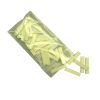YSI 6150 ROX Dissolved Oxygen Sensor
Features
- Utilizes luminescence lifetime detection of oxygen to provide the most stable measurements possible
- Microprocessor-controlled measurement system reduces drift and improves accuracy
- Easy to replace, durable membrane with a usable life of one year
- Expedited repair and warranty service
- Lifetime technical support
- More
Overview
The next generation YSI 6150 ROX is a luminescent-based dissolved oxygen sensor capable of conducting long-term oxygen measurements in severe fouling and low oxygen environments. Its rugged design and large measurement range make it ideal for sampling, flow cell, and groundwater measurements.
Integrated Wiping System
The ROX optical sensor uses an integrated wiping system to provide anti-fouling in the most hostile environments. Durable mechanical features include a non-corroding titanium wiper shaft, replaceable wiper shaft seal, and a new switch controlled wiper parking system to prevent mis-parking.
Luminescence Lifetime Method
The ROX sensing system is based on the luminescence lifetime method. This method was chosen because it offers the most stable, repeatable and sensitive method for oxygen detection, thus reducing sensor drift and prolonging deployment times.
Durable
YSI's optical DO membrane differs from the traditional electrochemical sensor membrane, requiring fewer steps for installation and less maintenance. ROX membranes will last for one year and are made of a durable material that is unlikely to be damaged in the field. The ROX sensor eliminates stirring dependency.
- Range: 0 to 500%; 0 to 50 mg/L
- Resolution: 0.1%; 0.01 mg/L
- Accuracy (0 to 200%): +/-1% of reading or 1% air saturation, whichever is greater
- Accuracy (200 to 500%): +/-15% of reading
- Accuracy (0 to 20 mg/L): +/-0.1 mg/L or 1% of reading, whichever is greater
- Accuracy (20 to 50 mg/L): +/-15% of reading
- Warranty: 2 years
In The News
VIMS study shows fish flee Chesapeake Bay hypoxia
A Virginia Institute of Marine Sciences study found that near-bottom fish in the Chesapeake Bay tend to move out of areas nearing hypoxia, according to a VIMS release. The study, which has spanned 10 years, found that biomass decreased in the middle of the Chesapeake Bay during mid-summer. That part of the bay typically experiences hypoxia due to algal blooms fed from nutrient runoff. A total of 48 sampling trips from 2002 through 2011 have shown that, when dissolved oxygen concentrations dip below 4 milligrams per liter, many near bottom fish leave the area. Analysis was limited to demersal, near bottom, fish and the same trends were not confirmed for fish higher in the water column.
Read MoreMississippi Gulf Coast fish kill expected to continue
Officials at the Mississippi Department of Marine Resources say that a recent fish kill along the state’s Gulf coast is the largest they’ve seen, according to KVUE. The fish kill has brought dead crabs, eels and stingrays ashore. Beachgoers were disturbed by the large-scale kill, but experts explained that conditions this year were to blame. With higher temperatures and low dissolved oxygen near the sea floor, creatures that live there were more likely to be affected. The fish kill, beginning July 1, was the first of 2013 for the area. It was expected to last several more days, but lessen over that period.
Read MoreStone Lab: Cyanobacteria Monitoring in Ohio Lakes
Microcystin, one of several toxins produced by the cyanobacteria that form harmful algal blooms (HABs), has become a popular topic of lake research as the human health impacts of HABs become better understood. Stone Lab is one of the leading groups in algal bloom research on Lake Erie and other lakes in Ohio. For more than 100 years, Stone Lab has conducted biology research and provided science education and outreach to the region. Over the years, thousands of individuals of varying ages have learned from the resources Stone Lab provides. Stone Lab’s Research Coordinator and Senior Researcher, Justin Chaffin, learned of Stone Lab while an undergraduate student at Bowling Green State University Fireland Campus.
Read More












